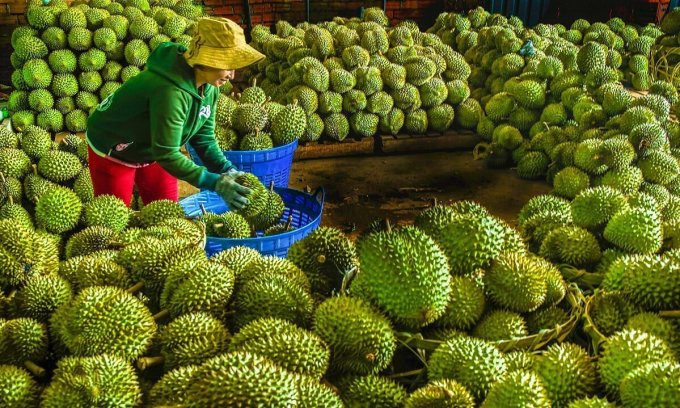Durian prices drop up to 30%
Grade B durians are priced at VND55,000-63,000 per kilogram, with a similar decrease from July and approximately 10% lower than the same period last year.
Durians at a warehouse in Dong Nai province, southern Vietnam. Photo by VnExpress/Phuoc Tuan |
Minh Thanh, a farmer in the Central Highlands province of Dak Lak, hopes that durian prices will recover by the season’s end. However, prolonged heavy rains have compromised the fruit’s quality, leading to low selling prices at the garden.
Similarly, Hong Anh, owner of 0.5-hectare durian crop in the Central Highlands province of Gia Lai, encounters challenges as buyers rescind their offers of VND80,000 per kilogram, even forfeiting deposits, compelling her to sell at only VND65,000 due to poor quality.
Anh attributes the price drop to the fruit’s diminished quality from excessive rainfall, particularly in new orchards that lack proper cultivation techniques. The hardened fruits complicate exports, with most being consumed domestically.
Manh Hoang, a trader in the Central Highlands, observes that durian quality suffers when grown alongside pepper and coffee. As the prices for pepper and coffee increase, many farmers prioritize them and apply unregulated fertilization, which degrades the durian quality. Some buyers only purchase durian for use in ice cream or for extracting the pulp, further complicating the export of whole fruits.
“I buy a few tons each day, but only 50% of the fruits meet export standards,” says Hoang. “The rest are sold in HCMC, Hanoi, and Da Nang.”
The General Department of Vietnam Customs reports that in the first seven months of 2024, Vietnam exported 476,130 tons of durian, valued at US$1.6 billion, representing a 50.5% increase in volume and 49.4% increase in value compared to the same period last year.
However, July saw a 30.8% decrease in both value and volume compared to June, totaling only US$280 million. Exports further declined to US$200 million in August.
Despite weather-related slowdowns, businesses note that durian export demand from China is recovering due to festive occasions. Improved weather from October is anticipated to enhance the quality of durian. Additionally, the volume of off-season produce has increased potentially, increasing export turnover.
Dang Phuc Nguyen, Secretary General of the Vietnam Fruit and Vegetable Association, explains that the reduction in export volume during July and August is temporary. From September, durian export turnover is expected to surge, potentially reaching nearly US$3 billion this year.
On Aug. 19, during a visit to China by Party General Secretary and State President To Lam, the two countries signed a protocol on exporting frozen durian, offering substantial opportunities for Vietnamese agriculture. Exports of frozen durian are anticipated to generate US$400-500 million this year.
In 2023, Vietnam exported approximately 500,000 tons of fresh durian, valued at US$2.3 billion, with 90% destined for China. The area planted with durian encompassed 154,000 hectares, yielding nearly 1.2 million tons, an annual increase of 15%.
Vietnam has around 151,000 hectares under durian, with the Central Highlands accounting for half of it. Other large growing areas include the southeast and the Mekong Delta regions with 25,000 ha and 42,000 ha.


Comments are closed.